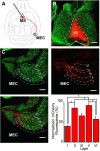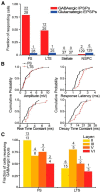GABAergic projections from the medial septum selectively inhibit interneurons in the medial entorhinal cortex
- PMID: 25505326
- PMCID: PMC4261098
- DOI: 10.1523/JNEUROSCI.1612-14.2014
GABAergic projections from the medial septum selectively inhibit interneurons in the medial entorhinal cortex
Abstract
The medial septum (MS) is required for theta rhythmic oscillations and grid cell firing in the medial entorhinal cortex (MEC). While GABAergic, glutamatergic, and cholinergic neurons project from the MS to the MEC, their synaptic targets are unknown. To investigate whether MS neurons innervate specific layers and cell types in the MEC, we expressed channelrhodopsin-2 in mouse MS neurons and used patch-clamp recording in brain slices to determine the response to light activation of identified cells in the MEC. Following activation of MS axons, we observed fast monosynaptic GABAergic IPSPs in the majority (>60%) of fast-spiking (FS) and low-threshold-spiking (LTS) interneurons in all layers of the MEC, but in only 1.5% of nonstellate principal cells (NSPCs) and in no stellate cells. We also observed fast glutamatergic responses to MS activation in a minority (<5%) of NSPCs, FS, and LTS interneurons. During stimulation of MS inputs at theta frequency (10 Hz), the amplitude of GABAergic IPSPs was maintained, and spike output from LTS and FS interneurons was entrained at low (25-60 Hz) and high (60-180 Hz) gamma frequencies, respectively. By demonstrating cell type-specific targeting of the GABAergic projection from the MS to the MEC, our results support the idea that the MS controls theta frequency activity in the MEC through coordination of inhibitory circuits.
Keywords: gamma; interneuron; lamina organization; medial entorhinal cortex; medial septum; theta.
Copyright © 2014 Gonzalez-Sulser et al.
Figures




Similar articles
-
Two septal-entorhinal GABAergic projections differentially control coding properties of spatially tuned neurons in the medial entorhinal cortex.Cell Rep. 2021 Mar 2;34(9):108801. doi: 10.1016/j.celrep.2021.108801. Cell Rep. 2021. PMID: 33657367
-
Optogenetic silencing of medial septal GABAergic neurons disrupts grid cell spatial and temporal coding in the medial entorhinal cortex.Cell Rep. 2024 Aug 27;43(8):114590. doi: 10.1016/j.celrep.2024.114590. Epub 2024 Aug 19. Cell Rep. 2024. PMID: 39163200
-
Synaptic Targets of Medial Septal Projections in the Hippocampus and Extrahippocampal Cortices of the Mouse.J Neurosci. 2015 Dec 2;35(48):15812-26. doi: 10.1523/JNEUROSCI.2639-15.2015. J Neurosci. 2015. PMID: 26631464 Free PMC article.
-
Structural modularity and grid activity in the medial entorhinal cortex.J Neurophysiol. 2018 Jun 1;119(6):2129-2144. doi: 10.1152/jn.00574.2017. Epub 2018 Mar 7. J Neurophysiol. 2018. PMID: 29513150 Review.
-
GABAergic interneuron origin of schizophrenia pathophysiology.Neuropharmacology. 2012 Mar;62(3):1574-83. doi: 10.1016/j.neuropharm.2011.01.022. Epub 2011 Jan 26. Neuropharmacology. 2012. PMID: 21277876 Free PMC article. Review.
Cited by
-
Anatomical and Electrophysiological Clustering of Superficial Medial Entorhinal Cortex Interneurons.eNeuro. 2017 Oct 16;4(5):ENEURO.0263-16.2017. doi: 10.1523/ENEURO.0263-16.2017. eCollection 2017 Sep-Oct. eNeuro. 2017. PMID: 29085901 Free PMC article.
-
The medial septum controls hippocampal supra-theta oscillations.Nat Commun. 2023 Oct 10;14(1):6159. doi: 10.1038/s41467-023-41746-0. Nat Commun. 2023. PMID: 37816713 Free PMC article.
-
Fan cells in lateral entorhinal cortex directly influence medial entorhinal cortex through synaptic connections in layer 1.Elife. 2022 Dec 23;11:e83008. doi: 10.7554/eLife.83008. Elife. 2022. PMID: 36562467 Free PMC article.
-
Microcircuits for spatial coding in the medial entorhinal cortex.Physiol Rev. 2022 Apr 1;102(2):653-688. doi: 10.1152/physrev.00042.2020. Epub 2021 Jul 13. Physiol Rev. 2022. PMID: 34254836 Free PMC article. Review.
-
Synaptic integrative mechanisms for spatial cognition.Nat Neurosci. 2017 Oct 26;20(11):1483-1492. doi: 10.1038/nn.4652. Nat Neurosci. 2017. PMID: 29073648 Review.
References
Publication types
MeSH terms
Grants and funding
LinkOut - more resources
Full Text Sources
Other Literature Sources
Research Materials
